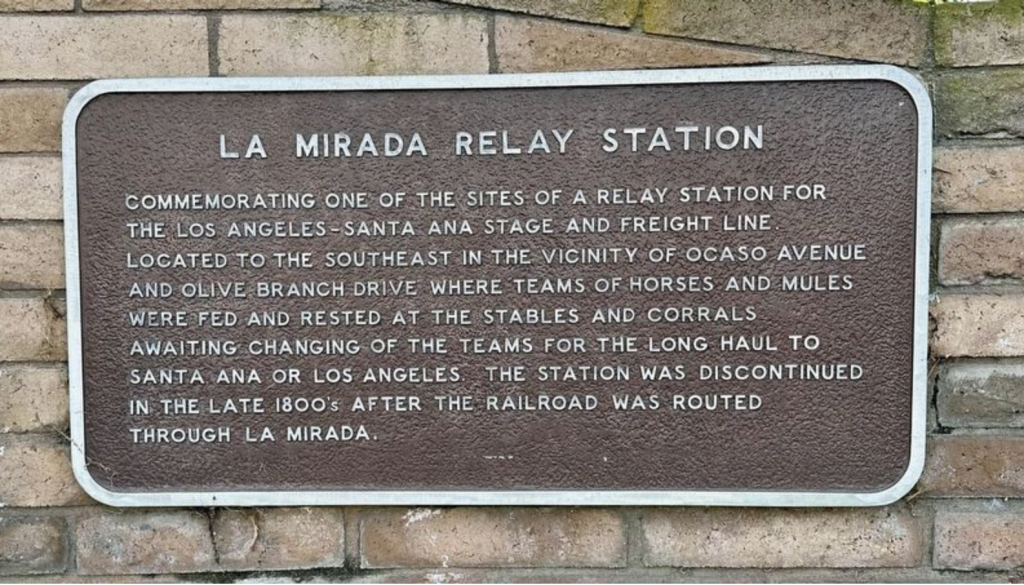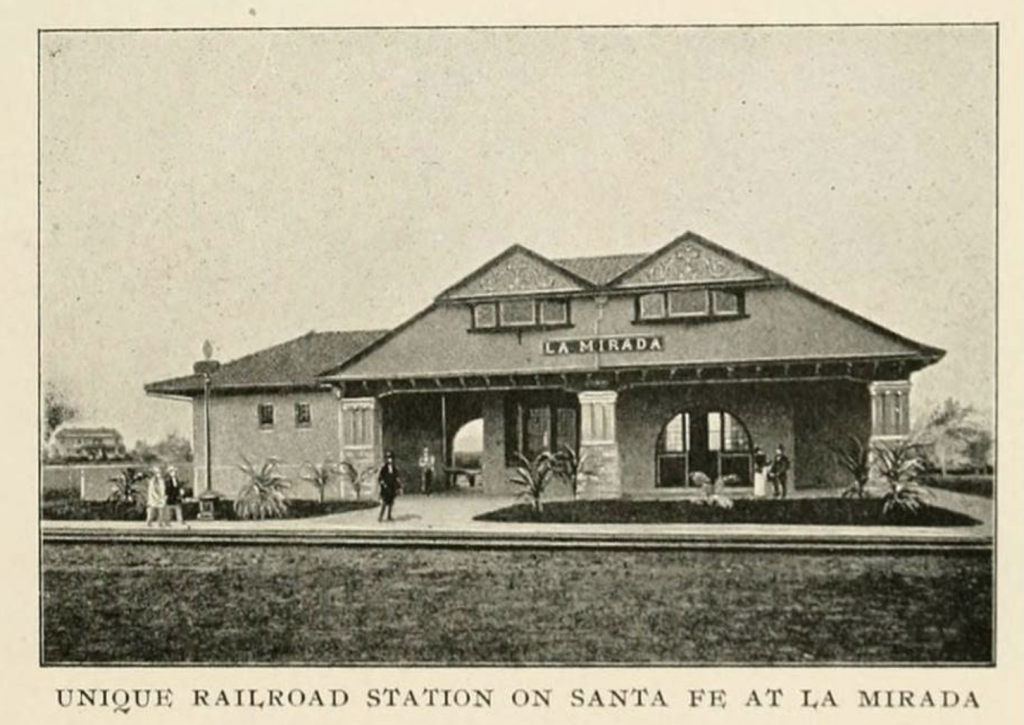 _________________________________
_________________________________


 “In towns and cities... there is no more important institution than the local paper.”
Warren Buffett
“In towns and cities... there is no more important institution than the local paper.”
Warren Buffett
June 21, 2024
Submitted by La Mirada Mayor John Lewis
La Mirada History: In the early to mid 1800’s, traveling on land typically meant going by foot, horseback, or your own personal mule/horse/ox – drawn carts. Once California attained statehood, in 1850, things changed and the stagecoach became a luxury (If you can call it a luxury) compared to the usual means of transportation. La Mirada was on the path of a well-known road called the Lower El Camino Real Road (Part of the El Camino Real Road that runs through California).
This was also known as the Los Angeles-San Diego Road. (See map of Savanna with the road running through it) This road was used by the Los Angeles-Santa Ana Stage and Freight Line which appears to be a segment of the Los Angeles- San Diego Stage Line prior to the arrival of the Southern Pacific Railroad in 1874 and the Santa Fe Railroad in 1888.

La Mirada Relay Station and 17-Mile House
La Mirada’s section of the stage lines had a “Relay Station” and Stage Stop located near Ocaso Avenue and Olive Branch (there is currently a plaque at the corner of Imperial Highway and Cordova Road commemorating this that states as follows:
Commemorating one of the sites of a relay station for the Los Angeles-Santa Ana stage and freight line located to the southeast in the vicinity of Ocaso Avenue and Olive Branch Drive where teams of horses and mules were fed and rested at the stables and corrals awaiting changing of the teams for the long haul to Santa Ana or Los Angeles.
The station was discontinued in the late 1800’s after the railroad was routed through La Mirada.) This is Stop #13 on the La Mirada History Tour.


Also in the area of La Mirada, in the upper Northwest Corner of La Mirada was the “Seventeen Mile Station” as part of the Stage Lines operated by the Bland Family. Back in 1869 when the Los Angeles-San Bernardino Land Company, an agency for the Stearns Ranchos, plotted the potential site of “Savanna” which would have been between Escalona Road and The Alondra Shopping Center, the transportation available would have been through the Los Angeles-Santa Ana stage and freight line.
The stage line was described as “Extending southeastward from Los Angeles, a small pueblo of 5,600 residents, its route followed approximately Telegraph Road to Norwalk Blvd. where it continued along a line with Myers Road, a station, the 17-Mile House, was on Myers (Meyers) Road just South of Leffingwell Road on the Bland Ranch.
From here it curved southeast to approximately the current railroad. There was a potential planned stop at the paper town of “Savanna” which never materialized. The coaches were the plush overland Concords, just open sides with rolled curtains for use in inclement weather.” (Source “Tales of the Old Days of “Old La Mirada”, La Mirada Lamplighter, 1973, by Bob Camp). Samuel Bland was a former highwayman and freight and stage driver before settling down and opening his 17-Mile house.

The Stage Coach Boom
These coaches, were drawn by two horses and accommodated up to 11 passengers, who each paid a fare of $20 for the two-day trip from Los Angeles to San Diego. Initially, these trips were scheduled once weekly, then twice a week, but by 1875 were running on a daily basis and reliably on-time unless waylaid by bandits hiding out in Laguna Canyon. (Source: Stage Coach Days, OCHistoryLand.com).
Some coaches were drawn by four or even up to six-horses depending on the freight and passengers. A lot of coaches were overcrowded with people standing inside and sitting many on top making them very unstable on a usually potholed dirt road. The roads were filled with danger in the form of bandits or runaway horses.

One article titled “Stage Coach Etiquette” stated that you should never spit on the leeward side of the stage or fire your pistols out the window as it may scare the horses who would then run wildly while you were in the coach holding on for dear life..
The stage coaches were useful bringing new residents and tourists into the area. In 1877, a couple of Santa Ana residents were hunting in a deep, wooded canyon that the Spaniards had called Cañon de la Madera for its abundance of timber. What ultimately captured the attention of area residents was “neither trees nor wildlife but a piece of blue-white quartz, embedded with what appeared to be silver. It was, and within the year Silverado City—later shortened to Silverado—was a thriving mining town that included two blacksmith shops, three hotels and seven saloons.
All of this industry, of course, required reliable transportation in and out of the area—and not any mere two-horse transport, but stagecoaches drawn by teams of six, capable of hauling both ore and passengers. These stagecoach runs occurred twice daily to Los Angeles and three times a day to Santa Ana and its railroad terminus. By 1883, however, the mining boom was over. The daily stages stopped running, and Silverado City shriveled down to near-ghost town status. (Source: Stage Coach Days, OCHistoryLand.com)


The La Mirada Railroad Station
The Southern Pacific Railroad came through other local towns in 1874, which reduced the use of the stage coaches to the roads and terminals in between the railroad stations. The Southern Pacific Railroad had secured control of the railway in Los Angeles in return for building its line from Northern California to Florence, to Anaheim. By the end of the year the route had gone through Downey to “North Walk” (Norwalk) which became a station when Gilbert Sproul dedicated 23 acres to Southern Pacific.
From there the tracks proceed to Buena Park through La Mirada to Anaheim in January 1875. By 1880 the old stage roads remained an important route for horse and wagons and eventually automobiles. In 1888, the Santa Fe Railroad extended its route into Los Angeles under a subsidiary company, California Southern Railroad paralleling the Lower El Camino Real through present day La Mirada.
The La Mirada Railroad Station was built in around 1893 which significantly reduced the use of the stage coaches, and they finally terminated the Relay station in La Mirada and the 17 Mile house on Myers Road.

The La Mirada Railroad Station was part of the 166 mile “Tour” that can be made in a day “That illustrates the beauties of Southern California” as stated in the 1903 newspaper AD showing a stop at he La Mirada station around 5:23 each day… (See attached AD from Santa Fe from 1903).
The station location can be found on Stop # 9 on the La Mirada History Tour. So enjoy your luxury ride on La Mirada’s smooth paved roads when you think of the past traveling options available at the turn of last century….


